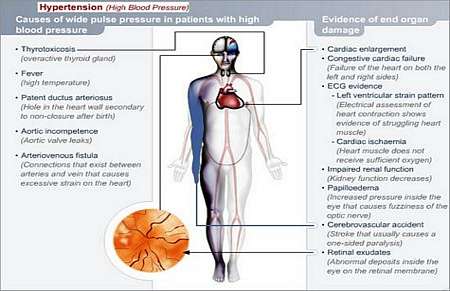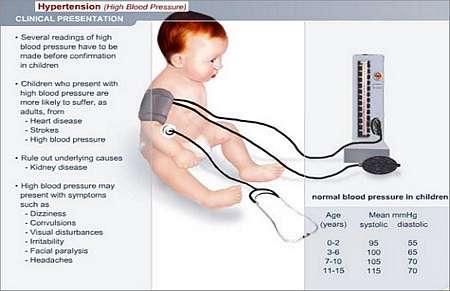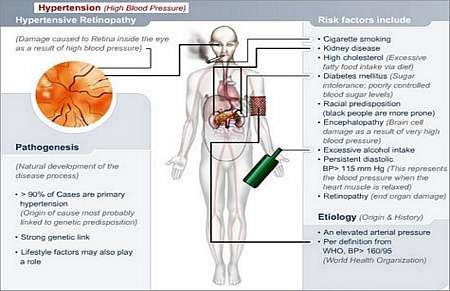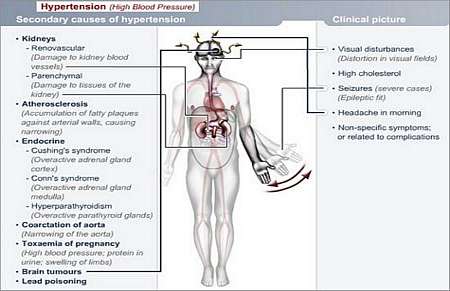What is HYPERTENSION (High blood pressure)?
The blood vessels that give oxygen-rich blood to the tissues of the body are abnormally narrow (constricted); as a result, the main pump (left ventricle) of the heart has to pump the blood out with a much greater force (pressure).
The force that the heart generates to pump the blood is measured as pressure. The pressure recorded in the upper arm is a close reflection of the pressure inside the heart. The higher the pressure, the harder the heart is working. When the heart empties into the blood vessels, it generates the highest pressure; this is called systolic (the time during which the heart empties) pressure.
As the heart relaxes and begins to fill, this pressure is lower; this is called the diastolic (filling phase of the heart) pressure. Clinically, these 2 blood pressure measurements are relevant; one during the emptying phase (systolic) and the other during the filling phase (diastolic). Blood pressure measurements are recorded in pressure units known as millimetres of mercury i.e. MmHg.
A normal systolic BP is less than 140 mmHg and diastolic less than 90 mmHg.
The BP readings are conventionally written as 140/90 mmHg i.e. systolic BP/diastolic BP.
How common is the condition?
This is a very common disease
- It is estimated that there are more than 50 million hypertensives in the USA
- Hypertension occurs more often in blacks than in whites (more blacks die of hypertension and its complications e.g. stroke, kidney failure, heart failure)
- With increasing age, an isolated increase in the systolic BP is much more common than is an elevation in both systolic and diastolic BP (this is known as isolated systolic hypertension)
- In about 95% of patients, the cause of hypertension is unknown and is referred to as essential hypertension; in the remainder, there are other causes for the hypertension (secondary hypertension); kidney disease accounts for most of this.
Unfortunately, only 1-2% of cases are due to a potentially curable disease.

What symptoms may the patient experience?
Most often, patients are entirely without symptoms. It has been called the silent killer.
Patients infrequently present with
- Headaches
- Palpitations
- A bleeding nose
However, these symptoms are not diagnostic of hypertension as they often occur in patients without high blood pressure.

How does it affect the body?
Many parts of the body are affected by hypertension; these include
Eyes
- Can be affected in several ways e.g. bleeding may occur at the back of the eye
- The evidence of high pressure in the brain can also be seen
- These abnormalities are seen with more severe hypertension
Heart muscle
- Heart muscle becomes thickened (hypertrophy), because of the high pressure the heart has to generate to push blood into the blood vessels of the body
- Hypertrophy of the heart is associated with a much higher incidence of complications such as stroke, heart failure or death
- The thickened heart muscle can be visualized using a cardiac ultrasound and, less often, using an ECG
- Patients with hypertrophied hearts have more severe and longstanding hypertension
Aorta
- The aorta (main artery arising from the left ventricle) can enlarge (dilate) and burst (dissection)
- This is a life-threatening complication; few patients reach hospital alive
- Emergency surgery is needed to remedy the situation
- Patients with hypertrophied hearts have more severe and longstanding hypertension
Kidneys
- Patients are at risk for kidney (renal) failure (this means that the kidneys are unable to eliminate the waste products in the circulation)
- In those with severe renal failure, the patient is unable to eliminate fluid from the body
- All these effects cause the patient to build up acid in the blood
- In addition, fluid collects in the lungs, abdomen and legs resulting in congestion
- This is a serious complication, because patients often need the aid of a dialysis (kidney) machine to filter the excess fluids and waste products out of their system (without dialysis, patients will die)
Brain
- Stroke is the most common complication
- In severe hypertension, the brain swells (hypertensive encephalopathy)
- This can lead to confusion, loss of consciousness, and ultimately, death


How is the diagnosis made and what special investigations are required?
The diagnosis of primary (essential) hypertension depends on the following
- Demonstrating that the systolic and/or the diastolic BP are consistently elevated above the normal range
- At least two BP readings should be made on separate occasions on 3 separate days before labelling a patient as hypertensive (for those with fluctuating BP levels, many more readings will be required)
- Patients with a BP greater than or equal to 90 mmHg (diastolic) or 140 mmHg systolic are considered hypertensive
Today, it is possible to measure BP every ½ hour for 24 hours
- This is called 24-hour ambulatory BP monitoring
- The patient wears a BP cuff around the arm for 24 hours during which time the BP is recorded
- This is done on an outpatient basis
- A computer reads a microchip in the BP monitor and prints out every measurement, as well as a 24-hour average
- This is a very useful test, as it will confirm the diagnosis of hypertension
- The test is also done in those patients with "uncontrollable" hypertension
Not infrequently, the BP becomes falsely elevated when the doctor measures the BP.
- This results in the over-diagnosis and potential over-treatment of hypertension
- Office or white coat hypertension refers to BP that is consistently elevated in the doctors office, but otherwise normal
Basic tests performed in the hypertensive patient
- History and examination
- Blood tests (full blood count; kidney function; cholesterol; uric acid - elevated in gout)
- Urine test for protein, blood and cells
- ECG
The younger the patient and the more severe the hypertension, the more extensive the evaluation should be; it includes
- Scans (ultrasound) of the kidney
- Tests to assess the blood-flow to the kidney
- Chest X-ray
Secondary causes include
- A spontaneously low potassium level in the blood
- Very hi
|